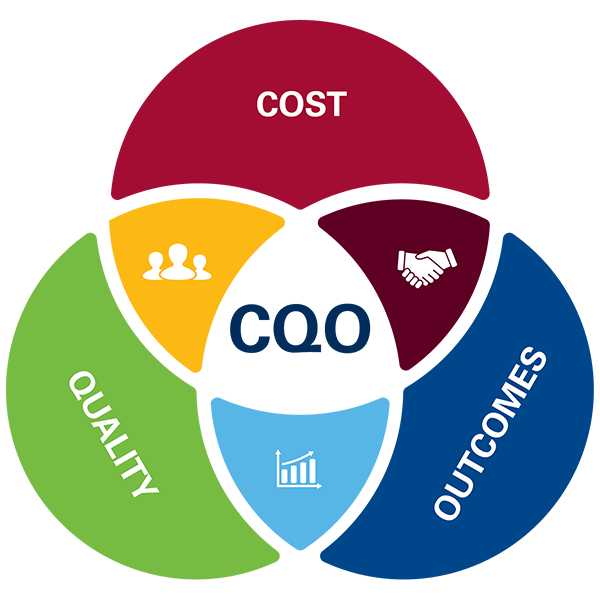
AHRMM Cost, Quality and Outcomes (CQO) Movement
Adopting a Clinically Integrated Supply Chain
The AHRMM CQO Movement frames the critical role supply chain professionals play in driving high quality care, at a more affordable cost, to deliver greater value to patients.

In today’s rapidly shifting health care landscape where declining reimbursements and changing payment policies are set to be the new norm, how do you ensure your health care organization delivers quality care at a more affordable cost?
As health care executives increasingly recognize that their organization’s success relies on the performance and effectiveness of the supply chain, how will you manage their expectations?
Join the Cost, Quality and Outcomes (CQO) Movement and add your voice to a thriving and ever-growing health care community dedicated to sharing and learning from each other to advance the supply chain strategy.



CQO: The Definition

The CQO Movement looks at the intersection of, and the relationship between:
Cost: all costs associated with caring for individuals and communities
Quality: care aimed at achieving the best possible health
Outcomes: financial results driven by exceptional patient outcomes
It is important that these relationships be considered together rather than in silos.
Explore educational opportunities and discover a wealth of materials developed specifically for health care supply chain professionals to help them effectively manage the quality and affordability of care.
Be a part of the movement and take the lead in revamping supply chain strategy by broadening its focus beyond cost, to include the correlation with quality and outcomes.

Introduction to CQO: Adopting a Clinically Integrated Supply Chain
This free course in the Supply Chain Fundamentals series provides an introduction to the CQO Movement and explores the advanced way of approaching health care supply chain.

AHRMM23 Cost, Quality and Outcomes Summit Recap
Health care supply chain leaders met in August 2023 in Orlando to discuss workforce recruitment, retention, and development; ongoing supply shortages and disruptions; and the ever-increasing financial pressures health care organizations face.
Collaborative, Data-Driven Approach to Opioid Management
This case study explores Vanderbilt University Medical Center (VUMC) approach to successfully monitor and manage opioids across its patient populations.
Post-Acute Care Strategy for Bundled Payments
The University of Alabama at Birmingham (UAB) Medicine breaks down their population health initiative exploring alternative payment models.
Members-Only Resource: Login to access.

AHRMM22 Cost, Quality and Outcomes Summit Recap
AHRMM has been focusing on the role supply chain leaders play in addressing both, as well as understanding, the intersection, and interdependencies between affordability and resiliency.

The Process of Operationalizing Contracts to Support CQO
This eLearning course teaches how to effectively operationalize contracts, resulting in an organized management process that will allow the entire organization to purchase quality products at the lowest cost.
Reduction or Elimination of Surgical Site Infections
Ochsner Health System (OHS) identified variation in their surgical skin prep solutions/supplies and practices/techniques within a hospital and across the system. This variation was identified as a contributing factor to SSIs.
Home Health Organization Provides High Quality Ostomy Care Through Product Formulary Standardization
This leading home health agency took a clinically driven approach, guided by supply chain’s product knowledge and expertise, to consolidate to an offering that would benefit all.

Integrating Physician Leadership in Supply Chain Management
Learn how to find the right physician leader and the skills needed, to build a value-based, patient-centric supply chain program. Learn best practice models and guidelines your team can manipulate to fit your own organization’s unique needs.

AHRMM21 Cost, Quality and Outcomes Summit Recap
AHRMM has been focusing on supplier diversity, equity, and inclusion (DEI) over the past few years and used the 2021 CQO Leadership Summit to explore the broader topic of health equity and its intersection with supply chain.
Baptist Health UDI Capture Work Group Case Study
The project objectives are to integrate supply chain information across all systems into one point of entry, interface data to all systems that use that data, and then define the fields and the processes that use that data.
Streamline and Re-Define Supplier Relationships to Promote Risk Sharing, Add Value, and Reduce Costs in the Perioperative Function
As supply chain professionals seek opportunities to add value to the continuum of care through the transition from a fee-for-service model to a risk-based model, they look to their suppliers to provide solutions focused on improving outcomes and lowering the total cost of patient care.
?
QUESTIONS ABOUT CQO
Check out the CQO Movement Frequently Asked Questions to learn more about the Movement, from how it's been developed to what it means for the future of health care supply chain.

